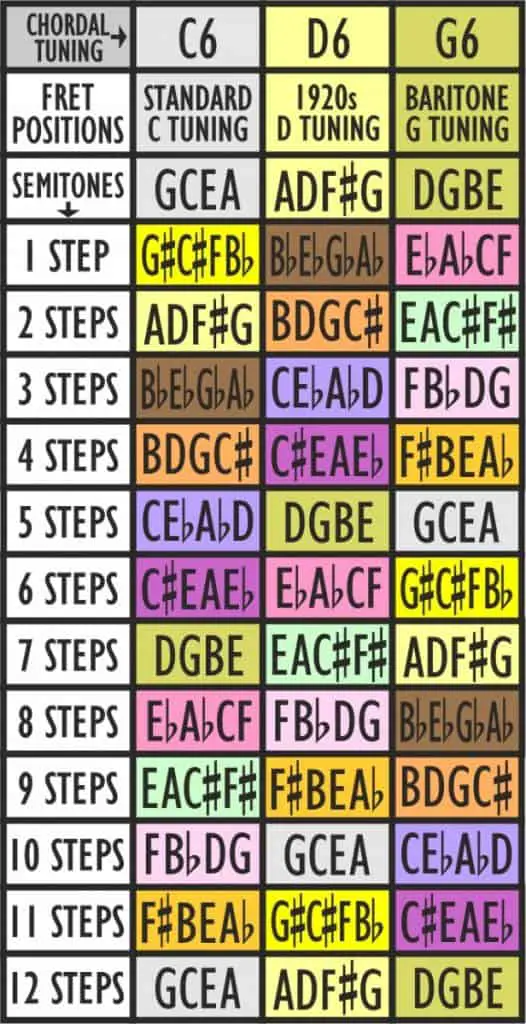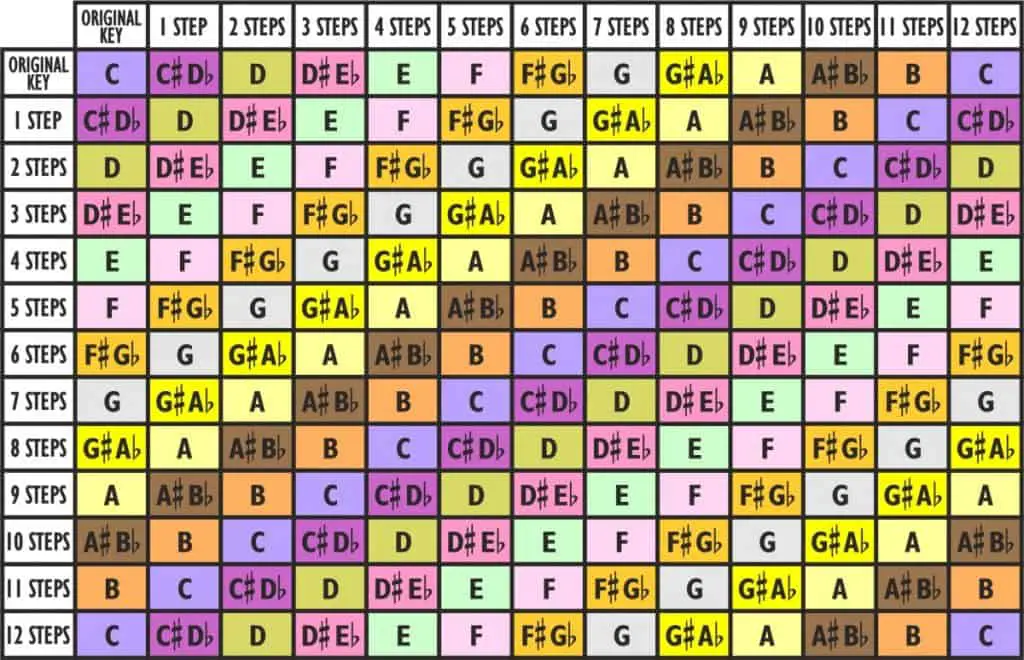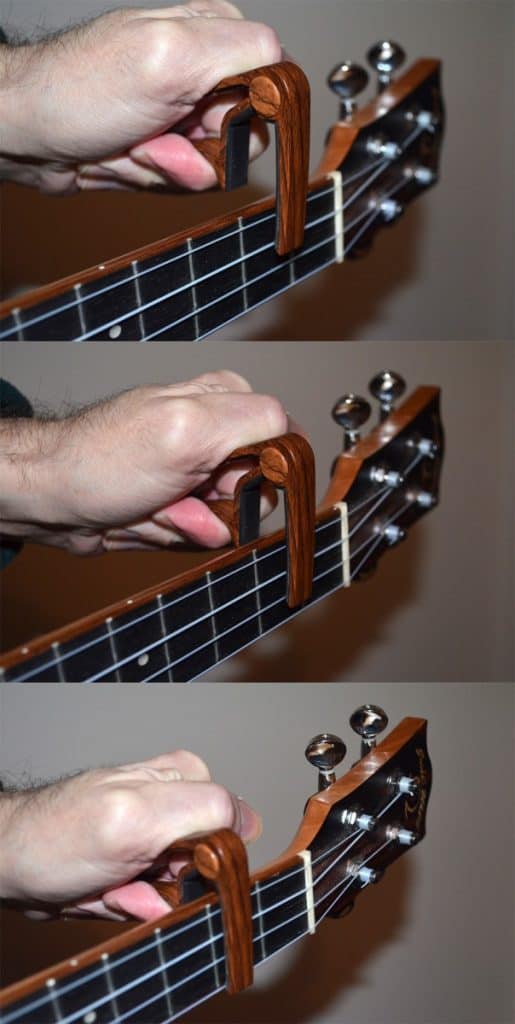There are plenty of frequently asked questions about ukulele capos, so I’ve taken the time to answer the most common ones below, with examples from my own instruments.
Whether you’re deciding if you need a uke capo at all, or want some professional tips on how to get the best out of one – here’s everything you need to know.
Covered in this Article:
Can You Use a Guitar Capo on a Ukulele? Will it Work?
If you’re already a guitar player and have a guitar capo, you’re probably wondering whether buying a ukulele-specific capo is worth the extra expense. Can you use your existing guitar capo with your ukulele?
Yes, you can use a guitar capo with a ukulele, in a pinch. However, there are some drawbacks, and you should really consider getting a size-specific capo for your ukulele.
Generally, it’s a sensible idea to look for an instrument-specific or more accurately, a size-specific capo. You can also make your own – covered later in this article.
First, I’ll discuss why you should (or shouldn’t) try to use a guitar capo on your uke.
The drawback with using a capo model designed for a guitar on a ukulele is it’s liable to be too wide and too bulky for the much narrower neck of a ukulele.
It’s very likely you’ll find the size of the capo to be somewhat of a hindrance with a number of the tighter fingering positions.
As you move up the fretboard, away from the capo, this becomes less of an issue, as your fingers won’t be feeling so squished. As an emergency capo, a guitar model will generally do, though it’s not ideal.
Guitar vs Ukulele Capos
Moving onto dedicated capos, it’s important to point out that the majority of these models will have been designed and manufactured with the smaller instrument in mind.
The overall size of a ukulele capo is a lot more manageable than the significantly larger guitar models and shouldn’t impede your playing style in most situations.
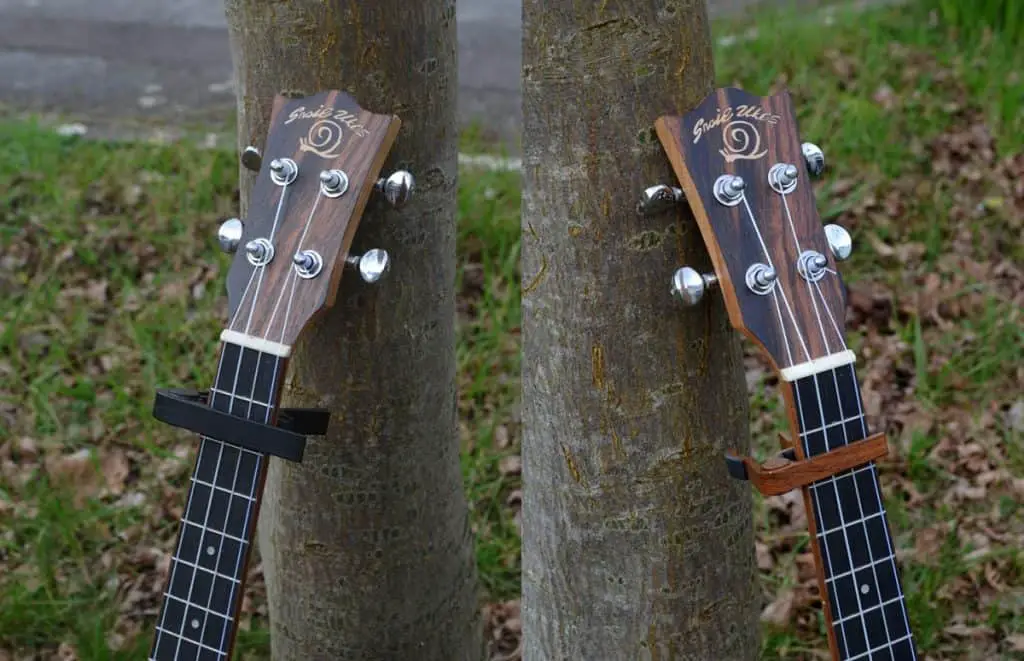
One pitfall is to avoid capos that claim they can be used for both a guitar and ukulele.
In the broadest sense, this may be true, but in reality, it’s very much a case of horses for courses and a device designed for one type of instrument is unlikely to be a perfect match for the other.
How to Make a DIY Ukulele Capo
In an emergency, where a capo isn’t available, you can create a DIY or makeshift ukulele capo using everyday objects.
You will need two things:
- A sturdy rubber band
- An old pencil, narrowish dowel rod, or a used popsicle stick.
Steps to create a DIY Ukulele Capo:
Cut your pencil or stick down to about half an inch wider than your fretboard and sand the ends until they’re smooth.
Now wrap the ends of your rubber band around one end of the stick and place the stick flat on your fretboard, with the rubber band underneath the curved part of the neck of your instrument.
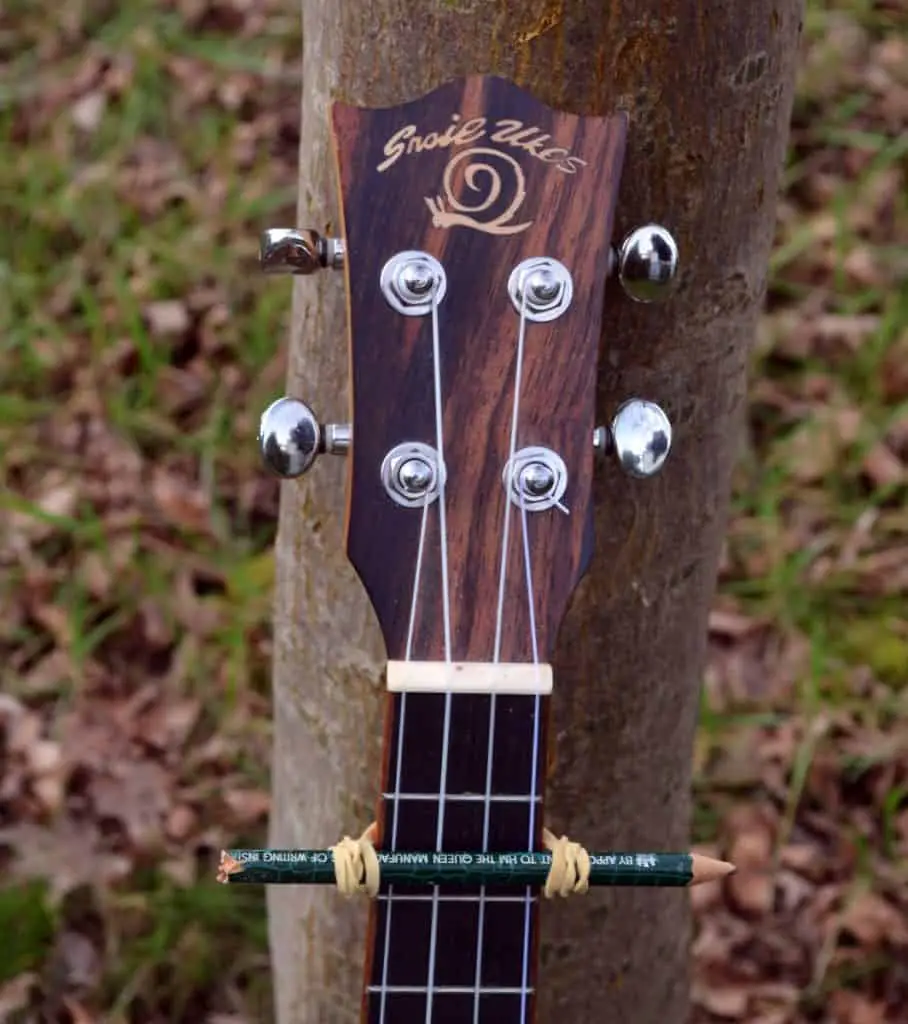
The important thing at this point is to double or triple over your rubber band until it clamps tightly onto the other end of your stick.
The crucial thing is that it fits snuggly and clamps the strings securely onto the fretboard.
Obviously, this is a very temporary solution, but one that can get you out of a hole if you need a homemade ukulele capo and can’t source one on the day.
Ukulele Songs With a Capo
The advantage of using a capo on your ukulele is in the ability to change key for several reasons:
- Change key to suit the range of your or another singer’s voice
- Play in a different key to accompany other musicians
- Play in a key with easier fingering positions
In the wider scheme of things, the number, scope and diversity of songs in different genres is almost limitless!
Here’s a list of several popular songs you can play with a capo on the ukulele:
- California Dreaming – Mamas & the Papas
- Circle Game – Joni Mitchell
- Don’t Look Back in Anger – Oasis
- Happy – Pharrell Williams
- I Wanna be Like You – Louis Prima (The Jungle Book)
- Lego House – Ed Sheeran
- Let it Be – The Beatles
- Over the Rainbow – Israel Kamakawiwo’ole
- Sloop John B – The Beach Boys
- Sound of Silence – Simon & Garfunkel
- Viva La Vida – Coldplay
- We Will Rock You – Queen
There are many chord tablature sites, so you shouldn’t feel restricted by choice.
Some even include a choice of ukulele, guitar or piano chords. If you find some of the listed fingering positions too different, there are often easier ways of playing the same chord, but using different fingers or on a different part of the fretboard.
Many of these alternatives can be found by typing in the chord name and Googling the images.
Alternatively, you might like to have a look at my ‘Ukulele Chord Bible’ (all three tunings available from Amazon), where many of the chords have three different versions.
Ukulele Capo Chart for Transposing or Tuning
Below, I’ve created a ukulele capo transposition chart.
To use the chart, find the key you wish to transpose into and find the step/fret position in the left-hand column (white).
For instance, if you wish to capo a baritone ukulele up to standard GCEA tuning, capo on the 5th fret.
To understand how a capo functions, you should think of it as a moveable nut (the little white or cream-colored block, the strings pass over before reaching the tuners on your headstock).
To give an example of that, today’s ukes tend to be configured to standard tuning (G-C-E-A, with the G nearest to your chin).
Back in the earlier days of the twentieth century, standard tuning tended to be set at a whole tone higher (A-D-F#-B).
If you want to utilize this tuning to play from the original 1920s and 1930s sheet music transcriptions, just capo your ukulele at the second fret and you instantly have A-D-F#-B (also known as ‘D or D6 tuning’). G-C-E-A is known as ‘C or C6 tuning’.
The alternative chart below highlights the individual notes found on your ukulele. For instance, if you capo your uke on the 4th fret (4 steps), the 3rd open string will transpose from open ‘C’ to open ‘E’.
You can also use the chart to transpose any chord sequence from one key to another.
To give an example, if your song contains the chords C, Fm and Bb7 and you want to transpose up four notes, run you finger either across or down the chart by 4 incremental steps and instantly transpose the chords into E, Am and D7.
The suffix doesn’t change, just the root note. For instance, minors will remain minors, sevenths remain sevenths and so on.
How to Use a Capo on a Ukulele
Most capos work by employing a strong spring mechanism in the body of the device. This allows it to clamp firmly onto the fretboard.
To open the jaws of the capo you generally use a pinch or pistol grip to slip it onto the neck and then place it where you want it along the fretboard. It then clamps firmly in place and will act as a temporary nut position.
A word of warning: make sure your strings are still running parallel to each other, as it’s easy to get a little slippage as you clamp it on. This can send a string slightly out of tune.
Not all capos utilize a spring, instead, they rely on a clamp and screw system. These are quite effective as you can vary the amount of pressure pushing down on the fretboard.
The spring-based models only have one set level of pressure for obvious reasons. It has to be said that sometimes depending on the quality of your capo or equally, the intonation of your ukulele, you may need to retune if the capo seems to be throwing things out a bit.
Often a little jiggling of the capo can help with this unwanted bi-product of using such a device.
One question which often crops up is where should I place the capo in relation to the nearest fret? The standard placement of any capo should sit just behind the fret underneath it. A common mistake is to clamp it down nearer to the fret above it. This can throw out the intonation and won’t give such a solid footing to it.
Pro Tip: Capos are notoriously easy to lose, so one rule of thumb is to clamp them onto the top of your headstock when you’ve finished using them.
If you’re packing your gear up after a gig, put it straight into the front pouch of your soft case or accessory compartment in a hard case. Suffice to say, the author of this blog doesn’t always follow his own advice!
Finally, one curious question I was once asked was if it’s unprofessional to use a capo and whether it’s frowned upon by purists.
Going by the same criteria, you could well accuse a mathematician of the same crime or misdemeanor if he or she dared to pull out a calculator!
But the simple answer is no, it’s not unprofessional to use a capo – it’s just another important part of the musician’s armoury!

